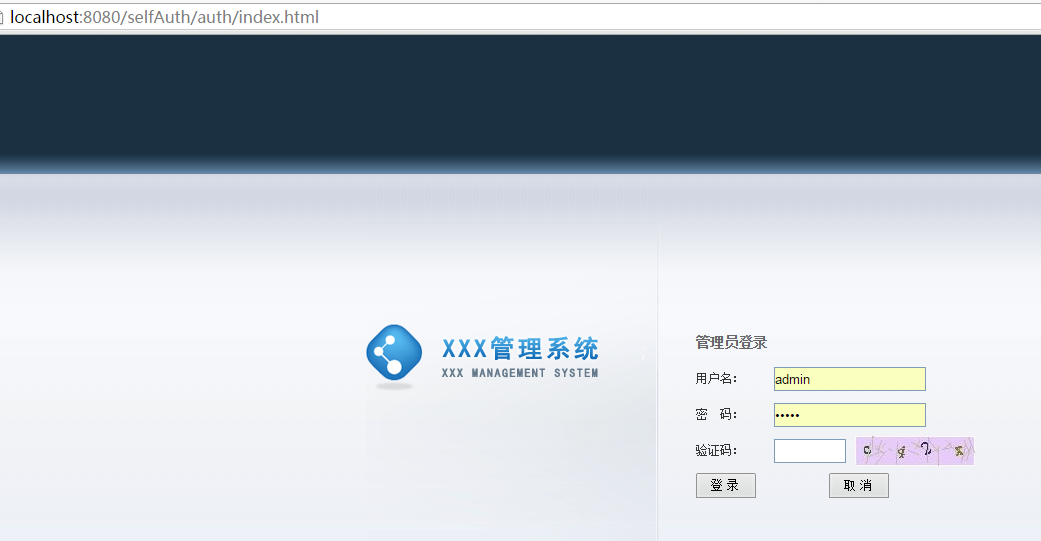首先,需要创建数据表,先建一个用户表User,和一个菜单表 Menu.还有用户所属角色,用来批量控制用户权限.
CREATE TABLE `tb_menu` (
`menu_id` int(10) NOT NULL AUTO_INCREMENT,
`menu_name` varchar(20) DEFAULT NULL,
`menu_url` varchar(100) DEFAULT NULL,
`parent_id` int(10) DEFAULT NULL,
PRIMARY KEY (`menu_id`)
) ENGINE=InnoDB AUTO_INCREMENT=21 DEFAULT CHARSET=utf8;
CREATE TABLE `tb_role` (
`role_id` int(10) NOT NULL AUTO_INCREMENT,
`role_name` varchar(20) DEFAULT NULL,
`rights` varchar(100) DEFAULT NULL,
PRIMARY KEY (`role_id`)
) ENGINE=InnoDB AUTO_INCREMENT=4 DEFAULT CHARSET=utf8;
CREATE TABLE `tb_user` (
`user_id` int(10) NOT NULL AUTO_INCREMENT,
`loginname` varchar(20) DEFAULT NULL,
`password` varchar(20) DEFAULT NULL,
`username` varchar(20) DEFAULT NULL,
`rights` varchar(100) DEFAULT NULL,
`status` tinyint(1) DEFAULT NULL,
`role_id` int(10) DEFAULT NULL,
`last_login` datetime DEFAULT NULL,
PRIMARY KEY (`user_id`)
) ENGINE=InnoDB AUTO_INCREMENT=19 DEFAULT CHARSET=utf8;在webRoot下编写一个index.jsp页面:
<%@ page language="java" import="java.util.*" pageEncoding="UTF-8"%>
<!DOCTYPE HTML PUBLIC "-//W3C//DTD HTML 4.01 Transitional//EN">
<html>
<head>
<title>My JSP 'index.jsp' starting page</title>
<meta http-equiv="pragma" content="no-cache">
<meta http-equiv="cache-control" content="no-cache">
<meta http-equiv="expires" content="0">
<meta http-equiv="keywords" content="keyword1,keyword2,keyword3">
<meta http-equiv="description" content="This is my page">
</head>
<body>
<script type="text/javascript">
document.location = "jsp/login.jsp";
</script>
<%-- <jsp:forward page="index.action"/> --%>
</body>
</html>
导入ssh需要的jar包,配置好环境:
web.xml:
<?xml version="1.0" encoding="UTF-8"?>
<web-app version="2.5" xmlns="http://java.sun.com/xml/ns/javaee"
xmlns:xsi="http://www.w3.org/2001/XMLSchema-instance"
xsi:schemaLocation="http://java.sun.com/xml/ns/javaee
http://java.sun.com/xml/ns/javaee/web-app_2_5.xsd">
<welcome-file-list>
<welcome-file>index.jsp</welcome-file>
</welcome-file-list>
<listener>
<listener-class>org.springframework.web.context.ContextLoaderListener</listener-class>
<!-- default: /WEB-INF/applicationContext.xml -->
</listener>
<context-param>
<param-name>contextConfigLocation</param-name>
<!-- <param-value>/WEB-INF/applicationContext-*.xml,classpath*:applicationContext-*.xml</param-value> -->
<param-value>classpath:beans.xml</param-value>
</context-param>
<filter>
<filter-name>encodingFilter</filter-name>
<filter-class>org.springframework.web.filter.CharacterEncodingFilter</filter-class>
<init-param>
<param-name>encoding</param-name>
<param-value>UTF-8</param-value>
</init-param>
</filter>
<filter-mapping>
<filter-name>encodingFilter</filter-name>
<url-pattern>/*</url-pattern>
</filter-mapping>
<filter>
<filter-name>OpenSessionInViewFilter</filter-name>
<filter-class>
org.springframework.orm.hibernate3.support.OpenSessionInViewFilter</filter-class>
<init-param>
<param-name>sessionFactoryBeanName</param-name>
<param-value>sf</param-value>
</init-param>
<init-param>
<param-name>singleSession</param-name>
<param-value>true</param-value>
</init-param>
<init-param>
<param-name>flushMode</param-name>
<param-value>AUTO</param-value>
</init-param>
</filter>
<filter-mapping>
<filter-name>OpenSessionInViewFilter</filter-name>
<url-pattern>/*</url-pattern>
</filter-mapping>
<filter>
<filter-name>struts2</filter-name>
<filter-class>org.apache.struts2.dispatcher.ng.filter.StrutsPrepareAndExecuteFilter</filter-class>
</filter>
<filter-mapping>
<filter-name>struts2</filter-name>
<url-pattern>/*</url-pattern>
<dispatcher>REQUEST</dispatcher>
<dispatcher>FORWARD</dispatcher>
</filter-mapping>
</web-app>
beans.xml:
<?xml version="1.0" encoding="UTF-8"?>
<beans xmlns="http://www.springframework.org/schema/beans"
xmlns:xsi="http://www.w3.org/2001/XMLSchema-instance"
xmlns:context="http://www.springframework.org/schema/context"
xmlns:aop="http://www.springframework.org/schema/aop"
xmlns:tx="http://www.springframework.org/schema/tx"
xsi:schemaLocation="http://www.springframework.org/schema/beans
http://www.springframework.org/schema/beans/spring-beans-2.5.xsd
http://www.springframework.org/schema/context
http://www.springframework.org/schema/context/spring-context-2.5.xsd
http://www.springframework.org/schema/aop
http://www.springframework.org/schema/aop/spring-aop-2.5.xsd
http://www.springframework.org/schema/tx
http://www.springframework.org/schema/tx/spring-tx-2.5.xsd">
<context:annotation-config />
<context:component-scan base-package="com.auth" />
<!--
<bean id="dataSource"
class="org.apache.commons.dbcp.BasicDataSource"
destroy-method="close">
<property name="driverClassName" value="com.mysql.jdbc.Driver" />
<property name="url" value="jdbc:mysql://localhost:3306/spring" />
<property name="username" value="root" />
<property name="password" value="bjsxt" />
</bean>
-->
<bean
class="org.springframework.beans.factory.config.PropertyPlaceholderConfigurer">
<property name="locations">
<value>classpath:jdbc.properties</value>
</property>
</bean>
<bean id="dataSource" destroy-method="close"
class="org.apache.commons.dbcp.BasicDataSource">
<property name="driverClassName" value="${jdbc.driverClassName}" />
<property name="url" value="${jdbc.url}" />
<property name="username" value="${jdbc.username}" />
<property name="password" value="${jdbc.password}" />
</bean>
<bean id="sf"
class="org.springframework.orm.hibernate3.annotation.AnnotationSessionFactoryBean">
<property name="dataSource" ref="dataSource" />
<property name="packagesToScan">
<list>
<value>com.auth.entity</value>
</list>
</property>
<property name="hibernateProperties">
<props>
<prop key="hibernate.dialect">
org.hibernate.dialect.MySQLDialect
</prop>
<prop key="hibernate.show_sql">true</prop>
</props>
</property>
</bean>
<bean id="hibernateTemplate" class="org.springframework.orm.hibernate3.HibernateTemplate">
<property name="sessionFactory" ref="sf"></property>
</bean>
<tx:annotation-driven transaction-manager="txManager" proxy-target-class="true" />
<bean id="txManager"
class="org.springframework.orm.hibernate3.HibernateTransactionManager">
<property name="sessionFactory" ref="sf" />
</bean>
</beans>struts.xml:
<?xml version="1.0" encoding="UTF-8" ?>
<!DOCTYPE struts PUBLIC
"-//Apache Software Foundation//DTD Struts Configuration 2.1//EN"
"http://struts.apache.org/dtds/struts-2.1.dtd">
<struts>
<constant name="struts.devMode" value="false" />
<constant name="struts.i18n.encoding" value="utf-8"></constant>
<constant name="struts.action.extension" value="html"></constant>
<package name="auth" extends="struts-default" namespace="/auth">
<action name="index" class="indexAction">
<result>/jsp/login.jsp</result>
</action>
</package>
</struts>
以上,环境就已经配置好,struts中的index.action用来访问登录页面使用.
编写struts的IndexAction类:
import org.springframework.stereotype.Component;
import com.opensymphony.xwork2.ActionSupport;
@Component
public class IndexAction extends ActionSupport{
public String execute() {
return SUCCESS;
}
}然后,启动服务就可以在浏览器访问了:























 380
380

 被折叠的 条评论
为什么被折叠?
被折叠的 条评论
为什么被折叠?








